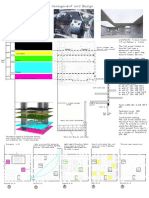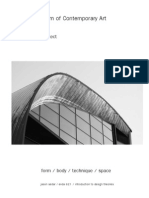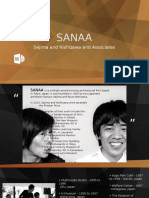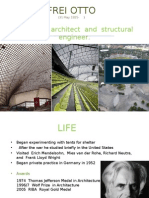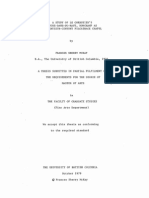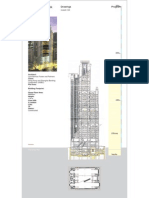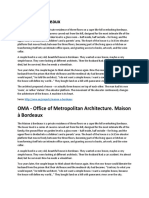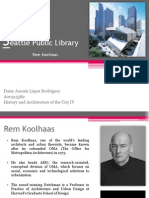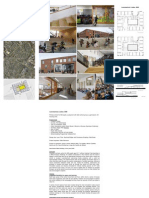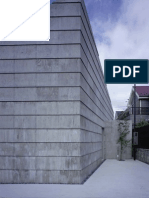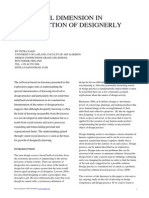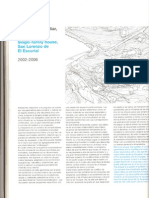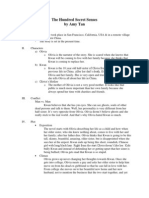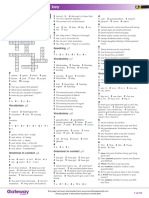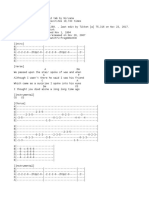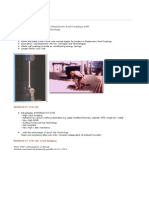Professional Documents
Culture Documents
Zollverein Design School Project by Sanaa
Uploaded by
ivicanikolicOriginal Description:
Original Title
Copyright
Available Formats
Share this document
Did you find this document useful?
Is this content inappropriate?
Report this DocumentCopyright:
Available Formats
Zollverein Design School Project by Sanaa
Uploaded by
ivicanikolicCopyright:
Available Formats
Zollverein school of management and design
SANAA architects Essen, Germany 2006
1
Development of the ruhr area
The Zollverein in the Ruhr district has lost its function as a major coalmine industry and today it has become a touristic attraction and it develops into a centre for design and the creative industry. Several institutes for design are at the Zollverein, such as the Designzentrum Westfalen and a choreographic centre. The Zollverein School of Management and Design is another major attractor in the area. There is an intellectual and physical network at the Zollverein that works as an important fundament for the development of this area. The start of the school was sponsored by the EU and the Westfalen district however, the school is a private institute. The building itself relates to the scale of the neighbouring industrial buildings, while on the same time creating a strong presence marking the entrance to the whole site. The building fuses the industrial past with its future of design and art.
The Zollverein school of management and design, Essen, Germany
Situation scale 1 / 1500
cafetaria
ateliers
auditorium
exposition
Groundfloor scale 1/200
First floor scale 1/200
seminar rooms Offices
library mediatheque
Second floor scale 1/200
Third floor scale 1/200
Roof terrace scale 1/200
Unique mix of business and design
Within the current development of the global market, design has become a decisive factor. Design is important for various sectors such as the consumer goods industry but also in the service sector. The Zollverein School focuses on the relation between design and management. The mix of the disciplines improves the knowledge of both. The combination makes both practices more competitive. Within the discipline of management traditional economic theory cannot be applied anymore. In a world where things change quickly one cannot rely on the idea that consistent thinking and logic will offer a solution.The designprocess offers a more sustainable solution in this environment.
SANAA on art and architecture
In her work, for example the Saishunkan Seiyaku Womens dormitory (Kumamoto , Japan, 1991), she provides a collective space in the building for all the individuals that can be used by everyone in the way he or she wants. All individual spaces, the private dormitories, are orientated towards this space.
Program organization and position of teaching
Concerning the teaching, the program in this building is organized in a non-hierarchical way. One large open space houses the program required for teaching. There are no subdivisions, individual spaces or even corridors. Formal and informal discussions and meetings are all in the same room. SANAA designed the ateliers as a kind of empty shell, or immaterial space in which the students and the teachers populate the learning landscape which starts to become vibrant when people start to use the space. The teacher-student relations are nonhierarchical as well. Usually the teacher is seated in front of the class and is therefore clearly on a different level, but at the Zollverein design school the teachers are on thesame level as the students. Together with the free circulation and the absence of visible construction elements this results in a variety of changing paths and meeting points which clearly shows the dynamic character of the school.
Combination of research and practice
The School is both theoretical as practical. There is a part for education and research and another part is the implementation of this in the working world. The focus at the Zollverein is on practical research projects. The Zollverein school can be
seen as one element responsible for the change from a centre of the production industry towards a network for the creative industry. ( Bruder, R., The Zollverein school of management )
Zollverein school of management and design
SANAA architects Essen, Germany 2006
Roofterrace
Offices
Research
Design studio
Cafe auditorium exhibition
North elevation scale 1/200
East elevation scale 1/500
West elevation scale 1/500
South elevation scale 1/500
Interpretation of program
There is no formality or intention created through the interpretation of a program. A building by SANAA can be a school, museum or theatre. It is almost impossible to recognize the building typology from the exterior. The construction of the school is kept to a visible minimum. The loadbearing facades and cores together result in large spans, which allowed construction to be visibly, nearly non-existent and contributed to maximum flexibility. Inside the loadbearing facades an ingenious system of hot waterpipes is incorporated resulting in a thin slab of concrete with excellent isolating properties. The thin facades now give the building a light appearance although the facades are comprised of concrete. The facades are penetrated with square openings, allowing for views of the surroundings and for moderate natural light into the interiors. It is not obvious where the floors are from the outside.
The spaces and presentation of the Zollverein
A view of the model made for the competition by SANAA The same view but now from the real building taken before completion
The non-hierarchical spaces in the Zollverein are different per floor. On the ground level a glass wall separates the auditorium from the other functions. The floor with the design studios is horizontally as well as vertically flexible. The large height allowes for big installations and artworks. This floor has no internal separating elements. The office floor is designed as a courtyard. Rooms are centered around patios. However, the structure of this floor with its glass walls and patios does not divide.
Zollverein school of management and design
Program public private
SANAA architects Essen, Germany 2006
3
private = employee private-collective = research collective = student public = visitors
Program organisation public private
1500 m2
1100 m2 900 m2 750 m2 440 m2 170 m
2
roofterrace offices for research/ staff/ visiting lecturers Library-seminarrooms
500 m2 250 m2 250 m2 200 m2
designstudio
cafeteria-exhibition-auditorium
foyer
theatre/ auditorium
museum/ exposition
cafe/ restaurant
library/ depot mediatheque
offices
laboratory/ atelier
parking
outside / roofterrace
The scale and shape of the building is derrived from the other buildings on the Zollverein area. The neighbouring buildings however, are completely outsized.
program / non program
space with program non program space separating element
Entrance vertical circulation Horizontal circulation free horizontal circulation
Open floorplan (level 1 + basis for all plans) Open floorplan with volumes (level 0 + 2) Pattern of workspaces (level 3)
Circulation
Directed movement through the volumes (level 0)
Free movement in the designschool (level 1)
Directed movement through the volumes (level 2)
Passage enclosing the officespace (level 3)
formal/ informal meetingplaces
servicespace fixed space for groupmeetings free space area for students / audience teacher service space fixed workspace informal meeting or flexible space
Option 1: free arrangement where teachers and students mix (level 1) Option 2: different groups can be formed that use the space differently (level 1) Fixed arrangement for groupmeetings (level 2)
flexible / fixed spaces
Informal meeting and flexible spaces for exposition and the cafe (level 0)
Informal meeting at the designlevel (level 1)
Informal meeting and flexible spaces along the edges (level 2)
Fixed network of offices and patios for informal meetings (level 3)
Programmatic organization
The program for the Zollverein is organized in a compact way. The different functions are stacked and the physical distance between each function is minimal. The stacking allows the different functions to work independently. They can all be accessed by the cores. There is a clear order between the levels. It becomes more private every time you ascend a floor. The distance for the designstudio to the more public places as well as the research area is as short as possible because it is located inbetween the two. The position of the offices just above the library is equally usefull. Together with the open floorplans that allows the program mass to be compact the intelligent stacking makes the relations between the different functions very intense.
own character in another way. The position of the windows creates a specific relation between inside and outside. From the outside the faade gets a uniform character through the square windows and from the inside it frames the site. The size and intensity differs and creates a different character per floor. Three levels have horizontally one line of windows. At level 0 the openings are larger and appear more frequent. In this way it becomes transparent and opens up for the public. Level 3 is similar to level 0. Here it is more important that enough light can enter. At the officelevel the openings are smaller and together with the circulation along the faade this floor has a more introverted character. The relation between the officespaces becomes more important. The main source of light are the patios that are positioned more centrally. The designstudio on level 1 has the most windows. Here the faade almost dissolves at the corners. Vertically there are up to 3 openings. This frames or filters the outside in a complex way but allows also a view of the interior from the outside. The designschool is the most expressive part from the exterior, yet it does not loose its private character.
The scale and shape of the building is derrived from the other buildings on the Zollverein area. The neighbouring buildings however, are completely outsized.
Expression of the faade and the influence on the interior
The scale of the volume relates to the other industrial buildings at the Zollverein area. The materials are different but have an equal strong character. Instead of the rigid brick, steel and glass facades bare concrete with large glass windows have been used. It gets its individual character in this way without loosing its connection to the site. The seemingly random position of the openings enhances its
You might also like
- Rolex SANAADocument12 pagesRolex SANAAcottchen6605No ratings yet
- Sanaa EssenDocument2 pagesSanaa EssenAntun JankovicNo ratings yet
- Robert Venturi and Postmodernism - Vanna Venturi House and Guild HouseDocument9 pagesRobert Venturi and Postmodernism - Vanna Venturi House and Guild HouseAnqa ParvezNo ratings yet
- Menil Museum HoustonDocument15 pagesMenil Museum HoustonSameer AnsariNo ratings yet
- 2014 10 28 - Holland - Rolex Learning Center PDFDocument3 pages2014 10 28 - Holland - Rolex Learning Center PDFcristhian Sandoval suyonNo ratings yet
- Atelier5 Siedlung HalenDocument9 pagesAtelier5 Siedlung HalenqwertzuiopoooNo ratings yet
- Alfriston School, Beaconsfield, BuckinghamshireDocument8 pagesAlfriston School, Beaconsfield, BuckinghamshireJayant NegiNo ratings yet
- The Integrated Programme For Street Children Was Started As Initiatives To Help Children Living On The Street Fulfil Their RightsDocument14 pagesThe Integrated Programme For Street Children Was Started As Initiatives To Help Children Living On The Street Fulfil Their RightsRadhika VijayNo ratings yet
- Kiasma Museum of Contemporary ArtDocument17 pagesKiasma Museum of Contemporary ArtrodrigoguabaNo ratings yet
- Pompidou Centre and Lloyd's Building Case StudyDocument24 pagesPompidou Centre and Lloyd's Building Case StudyAnutosh Chaudhuri25% (4)
- SendaiDocument15 pagesSendaiImtiyaz MohammadNo ratings yet
- Tadao AndoDocument32 pagesTadao AndoAanal ValaNo ratings yet
- Salk InstituteDocument35 pagesSalk Institutegreetarao88% (8)
- 2021-1 Case Study - Rudolph HallDocument19 pages2021-1 Case Study - Rudolph HallTimothée Ducoulombier100% (1)
- Adolf Loose - Life, Philosophy and WorksDocument11 pagesAdolf Loose - Life, Philosophy and WorksPreene Dias official100% (1)
- Louvre Abu Dhabi - Installation Design: © TDIC, Design: Ateliers Jean NouvelDocument4 pagesLouvre Abu Dhabi - Installation Design: © TDIC, Design: Ateliers Jean NouvelSilmi NoviaNo ratings yet
- Sendai Mediatheque 1Document10 pagesSendai Mediatheque 1suryakanthaNo ratings yet
- Smith House Case Study AnalysisDocument14 pagesSmith House Case Study AnalysisツsalihahNo ratings yet
- Liberation War Meuseum - Design-Studio-08 (23.02.2021)Document23 pagesLiberation War Meuseum - Design-Studio-08 (23.02.2021)Rased Islam RaselNo ratings yet
- ZAHA HADID - PHAENO - Science Centre WolfburgDocument9 pagesZAHA HADID - PHAENO - Science Centre WolfburgEmiliano_Di_Pl_3393No ratings yet
- Museo Internacional Del BarrocoDocument17 pagesMuseo Internacional Del BarrocoShadia HassanNo ratings yet
- Richard Rogers Lloyds LondonDocument46 pagesRichard Rogers Lloyds Londonlasio999No ratings yet
- Rem KoolhaasDocument11 pagesRem KoolhaasAnusha Ivaturi100% (1)
- Case Study of Wall Slab Structure Design Studio VDocument17 pagesCase Study of Wall Slab Structure Design Studio VSadek Ahmed Bappy100% (1)
- Zaha Hadid ArchitectDocument25 pagesZaha Hadid ArchitectAastha rathiNo ratings yet
- Vanna Venturi HouseDocument6 pagesVanna Venturi HouseAbdulla Km0% (1)
- SOHO Li Ze Tower Sarah OmranDocument21 pagesSOHO Li Ze Tower Sarah OmransarahNo ratings yet
- Mountain DwellingsDocument9 pagesMountain DwellingsYesica NugrahaNo ratings yet
- SANAADocument31 pagesSANAAChing ChingNo ratings yet
- S.NO. Function Literature Case Study-National Museum, New Delhi Virasat-e-Khalsa, Anandpur SahibDocument4 pagesS.NO. Function Literature Case Study-National Museum, New Delhi Virasat-e-Khalsa, Anandpur SahibMallika SinghNo ratings yet
- The Broad Museum Los AngelesDocument13 pagesThe Broad Museum Los Angeles20AR036 Madhavan SNo ratings yet
- Frei Otto Munich Olympic StadiumDocument18 pagesFrei Otto Munich Olympic StadiumJesus Rocha GasparriNo ratings yet
- Pérez Art Museum MiamiDocument8 pagesPérez Art Museum MiamiTheodora PatsNo ratings yet
- The Solitude of BuildingsDocument5 pagesThe Solitude of BuildingsMaria Daniela AlcantaraNo ratings yet
- Skylight Detail ManualDocument16 pagesSkylight Detail ManualMundhir Salim El-hajNo ratings yet
- A Study To Ronchamp by Le CorbusierDocument197 pagesA Study To Ronchamp by Le CorbusierAnonymous Psi9Ga100% (2)
- Thesis Report - SoumilDocument184 pagesThesis Report - SoumilSOUMIL SENAPATINo ratings yet
- Analysis Hong Kong BankDocument3 pagesAnalysis Hong Kong BankNadbir AhmedNo ratings yet
- ST Mary AxeDocument1 pageST Mary Axevibha bNo ratings yet
- Le CorbusierDocument21 pagesLe CorbusierAbhishek GandhiNo ratings yet
- Architecture - Seattle Public LibraryDocument10 pagesArchitecture - Seattle Public Libraryapi-255565524100% (2)
- Sendai Mediatheque: Toyo ItoDocument11 pagesSendai Mediatheque: Toyo ItoEduardo Cesar GentileNo ratings yet
- DiagoonHousingDelft2016 Herman HertzDocument20 pagesDiagoonHousingDelft2016 Herman HertzHiren SavaliyaNo ratings yet
- James StirlingDocument17 pagesJames StirlingAnupriya SaraswatNo ratings yet
- Hans Kollhoff Review of HousingDocument30 pagesHans Kollhoff Review of HousingVIgnesh100% (2)
- Renzo Piano Building Workshop - Shop (Ginza, Tokyo)Document2 pagesRenzo Piano Building Workshop - Shop (Ginza, Tokyo)lino7No ratings yet
- Bauhaus Building, GropiusDocument3 pagesBauhaus Building, Gropiusivicanikolic100% (2)
- MVRDV 'S WoZoCo Apartment BuildingDocument10 pagesMVRDV 'S WoZoCo Apartment BuildingJosé SilvaNo ratings yet
- Maison À BordeauxDocument11 pagesMaison À BordeauxMaja BaldeaNo ratings yet
- Seattle Public LibraryDocument18 pagesSeattle Public LibraryDaisy Rodriguez100% (2)
- Kolumba MuseumDocument2 pagesKolumba MuseumshankariNo ratings yet
- Louvre Abu DhabiDocument5 pagesLouvre Abu DhabiSharadhi KattiNo ratings yet
- Daniel LibeskindDocument34 pagesDaniel LibeskindShubha50% (2)
- The senses in interior design: Sensorial expressions and experiencesFrom EverandThe senses in interior design: Sensorial expressions and experiencesNo ratings yet
- Dutch Schools, Architecture StudyDocument18 pagesDutch Schools, Architecture StudyNicholas SocratesNo ratings yet
- Nid Case StudyDocument29 pagesNid Case StudyIshani88% (8)
- El Croquis 139 - Proyecto - Rolex PDFDocument6 pagesEl Croquis 139 - Proyecto - Rolex PDFCatlikesNo ratings yet
- Atelier Lorentzen LangkildeDocument1 pageAtelier Lorentzen LangkildePatrascu Cristian EmanuelNo ratings yet
- Following An International Design Competition JWA and NADAAA Were Appointed As Architects ToDocument3 pagesFollowing An International Design Competition JWA and NADAAA Were Appointed As Architects ToKrishnanunniNo ratings yet
- Pitched Green RoofsDocument18 pagesPitched Green RoofsivicanikolicNo ratings yet
- Manuel For Usage of Brick and Tile in The Construction ProcessDocument50 pagesManuel For Usage of Brick and Tile in The Construction ProcessivicanikolicNo ratings yet
- KATALOG STANOVA JNA 3 - Stanovi U Porodičnim Zgradama (1968-1986)Document80 pagesKATALOG STANOVA JNA 3 - Stanovi U Porodičnim Zgradama (1968-1986)ivicanikolicNo ratings yet
- Nolan - Taper Loc - Frameless Glass BalustradeDocument8 pagesNolan - Taper Loc - Frameless Glass BalustradeivicanikolicNo ratings yet
- MAPS - Facades - GlassDocument86 pagesMAPS - Facades - GlassivicanikolicNo ratings yet
- MAPS - Store FrontsDocument44 pagesMAPS - Store FrontsivicanikolicNo ratings yet
- MAPS - Lens FlareDocument14 pagesMAPS - Lens FlareivicanikolicNo ratings yet
- Advances in Building EnergyDocument265 pagesAdvances in Building EnergyivicanikolicNo ratings yet
- Innovative Strategies For Big Cities Public LibrariesDocument13 pagesInnovative Strategies For Big Cities Public LibrariesivicanikolicNo ratings yet
- MAPS BricksDocument5 pagesMAPS BricksivicanikolicNo ratings yet
- Architecture Sustainable Building DesignDocument100 pagesArchitecture Sustainable Building DesignmalizverkoNo ratings yet
- Shkatulka ШкатулкаDocument222 pagesShkatulka ШкатулкаAelleia100% (3)
- MAPS WallsDocument27 pagesMAPS WallsivicanikolicNo ratings yet
- MAPS StonesDocument32 pagesMAPS StonesivicanikolicNo ratings yet
- MAPS TilesDocument42 pagesMAPS TilesivicanikolicNo ratings yet
- MAPS MarblesDocument453 pagesMAPS MarblesivicanikolicNo ratings yet
- MAPS PatternsDocument64 pagesMAPS PatternsivicanikolicNo ratings yet
- This Is Hybrid - Texts - ArchitectureDocument38 pagesThis Is Hybrid - Texts - ArchitectureivicanikolicNo ratings yet
- Urban Hibridization TextsDocument20 pagesUrban Hibridization TextsivicanikolicNo ratings yet
- The Social Dimension in Construction of Designerly KnowingDocument7 pagesThe Social Dimension in Construction of Designerly KnowingivicanikolicNo ratings yet
- Traditional Serbian House - Hand DrawingsDocument19 pagesTraditional Serbian House - Hand DrawingsivicanikolicNo ratings yet
- MAPS CarpetsDocument44 pagesMAPS CarpetsivicanikolicNo ratings yet
- NEXT - Density Series-Collective Housing in ProgressDocument24 pagesNEXT - Density Series-Collective Housing in Progressivicanikolic0% (1)
- Toyo Ito - TOD's ProjectDocument8 pagesToyo Ito - TOD's ProjectivicanikolicNo ratings yet
- SANAA ProjectsDocument52 pagesSANAA Projectsivicanikolic100% (1)
- Architectural GaitsDocument8 pagesArchitectural GaitsivicanikolicNo ratings yet
- Why Design Labs?Document10 pagesWhy Design Labs?ivicanikolicNo ratings yet
- A Social Language of Objects and ArtifactsDocument8 pagesA Social Language of Objects and ArtifactsivicanikolicNo ratings yet
- Eduardo Arroyo - Excerpts From MonographyDocument32 pagesEduardo Arroyo - Excerpts From MonographyivicanikolicNo ratings yet
- From Program To Design - John HeintzDocument8 pagesFrom Program To Design - John HeintzivicanikolicNo ratings yet
- 12 Books of Hours For 2012Document106 pages12 Books of Hours For 2012Joe Magil100% (2)
- Fire Hose ReelDocument2 pagesFire Hose ReelpastorgeeNo ratings yet
- On The Day CoordinationDocument6 pagesOn The Day CoordinationAna Marie SuganobNo ratings yet
- Your Opinion On Jose Rizal's Patriotism As Expressed in His Work To The Young Women of Malolos (Letter)Document4 pagesYour Opinion On Jose Rizal's Patriotism As Expressed in His Work To The Young Women of Malolos (Letter)Jayson ManoNo ratings yet
- Chapter 8 Test and ReviewDocument5 pagesChapter 8 Test and Reviewapi-232613595No ratings yet
- The Hundred Secret SensesDocument4 pagesThe Hundred Secret SensesMiguel SantosNo ratings yet
- A2 Workbook Answer Key 1Document16 pagesA2 Workbook Answer Key 1samuel54% (13)
- Piongs QuizDocument13 pagesPiongs QuizCharlstom MorenoNo ratings yet
- Would You Like Eddy Current, Video & Strip Chart in One Portable Case?Document2 pagesWould You Like Eddy Current, Video & Strip Chart in One Portable Case?Daniel Jimenez MerayoNo ratings yet
- How Does Priestley Explore Responsibility in An Inspector CallsDocument1 pageHow Does Priestley Explore Responsibility in An Inspector CallsloklkioNo ratings yet
- Windows SDKDocument15 pagesWindows SDKIBRAHIMNo ratings yet
- DUNGEONS ExtendidoDocument112 pagesDUNGEONS ExtendidoEdgardo De La CruzNo ratings yet
- 66 Fluency Boosting German Phrases PDFDocument13 pages66 Fluency Boosting German Phrases PDFAyesha ChaudryNo ratings yet
- S.No. Case No. Name of The Parties Case Date: RD TH NDDocument4 pagesS.No. Case No. Name of The Parties Case Date: RD TH NDAasim Ahmed ShaikhNo ratings yet
- Sequence of Works For Building ConstructionDocument2 pagesSequence of Works For Building ConstructionBoni Amin76% (34)
- Notes Canterbury Tales Prologue T.ed.Document14 pagesNotes Canterbury Tales Prologue T.ed.Purvi GajeraNo ratings yet
- Section A-A Detail of Rubble Paving at Wing Wall: 60Mm Thk. Wearing CourseDocument1 pageSection A-A Detail of Rubble Paving at Wing Wall: 60Mm Thk. Wearing CoursesathiyanNo ratings yet
- Burke Cursing ApostlesDocument25 pagesBurke Cursing ApostlesFolarin AyodejiNo ratings yet
- 17 Paket Grammar PDFDocument72 pages17 Paket Grammar PDFSyekhmundu jambukarangNo ratings yet
- The Man Who Sold The WorldDocument9 pagesThe Man Who Sold The WorldJoell Rojas MendezNo ratings yet
- G1 HinduismDocument40 pagesG1 HinduismJulie-Ar Espiel SibalaNo ratings yet
- Dieter Rams 10 Principles of Good Design 2Document87 pagesDieter Rams 10 Principles of Good Design 2PonHarshavardhanan100% (1)
- AQS-001 (F) Type A PDFDocument1 pageAQS-001 (F) Type A PDFbarabatina100% (1)
- DVP 505A User GuideDocument22 pagesDVP 505A User GuideMillsElectricNo ratings yet
- Geo TestDocument2 pagesGeo Testleta jima100% (1)
- Rhoplex Ec-1791 QsDocument7 pagesRhoplex Ec-1791 QsA MahmoodNo ratings yet
- Atlantis PoemDocument1 pageAtlantis PoemGeorge PatrickNo ratings yet
- DeskTop LAA6E84Document164 pagesDeskTop LAA6E84Muhammad AbubakarNo ratings yet
- High Impact CopywritingDocument17 pagesHigh Impact CopywritingdurvalmartinsNo ratings yet
- Load SchedDocument1 pageLoad SchedNikko Catibog GutierrezNo ratings yet

